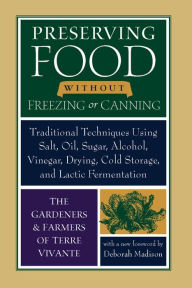First published in hardcover in 2002, Local Flavors was a book ahead of its time. Now, imported food scares and a countrywide infatuation with fresh, local, organic produce has caught up with this groundbreaking cookbook, available for the first time in paperback.
Deborah Madison celebrates the glories of the farmers’ markets of America in a richly illustrated collection of seasonal recipes for a profusion of produce grown coast to coast. As more and more people shun industrially produced foods and instead choose to go local and organic, this is the ideal cookbook to capitalize on a major and growing trend.
Local Flavors emphasizes seasonal, regional ingredients found in farmers’ markets and roadside farm stands and awakens the reader to the real joy of making a direct connection with the food we eat and the person who grows it. Deborah Madison’s 350 full-flavored recipes and accompanying menus include dishes as diverse as Pea and Spinach Soup with Coconut Milk; Rustic Onion Tart with Walnuts; Risotto with Sorrel; Mustard Greens Braised with Ginger, Cilantro, and Rice; Poached Chicken with Leeks and Salsa Verde; Soy Glazed Sweet Potatoes; Cherry Apricot Crisp; and Plum Kuchen with Crushed Walnut Topping.
Covering markets around the country from Vermont to Hawaii, Deborah Madison reveals the astonishing range of produce and other foods available and the sheer pleasure of shopping for them. A celebration of farmers and their bounty, Local Flavors is a must-have cookbook for anyone who loves fresh, seasonal food simply and imaginatively prepared.
Read More
From the Publisher
Her books have sold more than 700,000 copies.PRAISE FOR LOCAL FLAVORS“For anyone trying to eat locally and seasonally, Local Flavors is indispensable.” —Michael Pollan, author of The Omnivore’s Dilemma
bn.com
The Barnes & Noble Review
Farmers' markets are the new village green, says award-winning cookbook author Deborah Madison. This movement has blossomed into more than 3,000 markets across the country, places where you can run into old friends, meet new ones, discover new fruits and vegetables, and go home with bags and bags of fresh, delicious, and seasonal produce.
For all of us who go to the markets and get completely carried away with what we see, Madison has designed more than 350 recipes that take advantage of this, whether it's the greens, salad, and herbs of the spring's bounty or the root vegetables, apples, and squash of the fall harvest. Her recipes highlight seasonal ingredients (Spring Risotto with
Sorrel, Roast Chicken with Herbs Under the Skin, or Parsnip Salad with Walnuts and Dates) as well as regional foods (Soft Tacos with Roasted Green Chiles or Hickory Nut Torte). There are recipes using market foods found in the winter months, too.
The chapters in Local Flavors are organized not by courses of the meal, but by seasons and botanical families, like the stone fruits and the nightshades (tomatoes, peppers, eggplants). In each chapter, Madison reports on a visit to a particular market -- say Cortez and Durango in mid-August or San Francisco's Ferry Plaza Market in October -- and composes meals from the market produce available at that time. Dozens of full-color photos of the markets, the shoppers, the farmers, and the dishes complete the course.
Madison, well known for The Greens Cookbook and her award-winning Vegetarian Cooking for Everyone, also gives some good advice for shopping at farmers' markets:
- Plan to spend some leisurely time at the market.
- If you don't recognize what you see, or need a tip on how to cook it, ask the growers.
- Bring cash.
- "Take a feast-now approach when shopping.... A favorite peach might be around for only two weeks, so buy accordingly and enjoy."
(Ginger Curwen)
Publishers Weekly
Madison (Vegetarian Cooking for Everyone) celebrates the seasonality of produce from farmers' markets across the country in this sophisticated cookbook. Sharing a few meat recipes, Madison has organized this collection by category (Corn and Beans, Stone Fruits, etc.) and included recipes mostly using vegetables and fruits. Not just another how-to for arranging tomatoes on a plate, the book presents such year-round recipes as Cabbage and Potato Gratin with Sage, or Corn and Squash Simmered in Coconut Milk with Thai Basil, alongside tributes to highlighted markets. Vegetarians will welcome main courses such as Braised Root Vegetables with Black Lentils and Red Wine Sauce or Asparagus and Wild Mushroom Bread Pudding. Recipes do demand close reading: one calls for a can of coconut milk but uses only part. However, shoppers learn how to use sunchokes (Sunchoke Bisque with Hazelnut Oil), Concord grapes (Concord Grape Tart) and even hickory nuts (Hickory Nut Torte with Espresso Cream). Madison's custom preparations suit farmer's market boutique style: she cuts each type [of squash] in the way that best preserves its form: lengthwise for the zucchini, crosswise for pattypans and round squash. Chefs will love the Herbs and Alliums chapter introducing Marjoram Pesto with Capers and Olives and Herb Dumplings for Soups and Ragouts. Also strong are composed salads, such as Avocado and Grapefruit Salad with Pomegranates and Pistachios, the eggs and cheese chapter and extensive fruits and desserts, such as Blood Orange Jelly and Greg's Huckleberry Pie. This is a book cooks will reach for to enliven repertoires. (June) Copyright 2002 Cahners Business Information.
Library Journal
Some 350 recipes for all seasons. Copyright 2001 Cahners Business Information.
Read More









